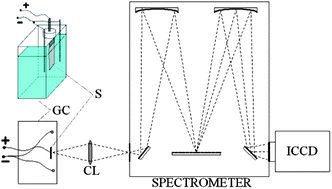In this paper we present the results of intensity measurements of D1 (589.5224 nm) and D2 (588.9950 nm) sodium doublet spectral lines emitted from a short-lifetime plasma randomly appearing across the aluminum anode surface during its electrolytic oxidation from the water solution of boric acid with sodium tetraborate. We found that the D2 to D1 intensity ratios were not constant, varying from 2 to 1.2. Assuming that the plasma is in local thermal equilibrium it is expected that the intensity ratio of sodium doublet components equals the ratio of the statistical weights of the atomic sublevels corresponding to the electronic transitions (D1: 32P1/2–32S1/2, D2: 32P3/2–32S1/2) i.e. 2. After detailed analyses of a series of spectra obtained by applying different detection parameters, like exposure time, slit width, detection mode, and number of accumulations, we attributed the anomalous D2/D1 intensity ratio to the effect of approaching a saturation condition of the charge coupled device detector and thus to an early indication of saturation occurrence.

You have access to this article
 Please wait while we load your content...
Something went wrong. Try again?
Please wait while we load your content...
Something went wrong. Try again?


 Please wait while we load your content...
Please wait while we load your content...